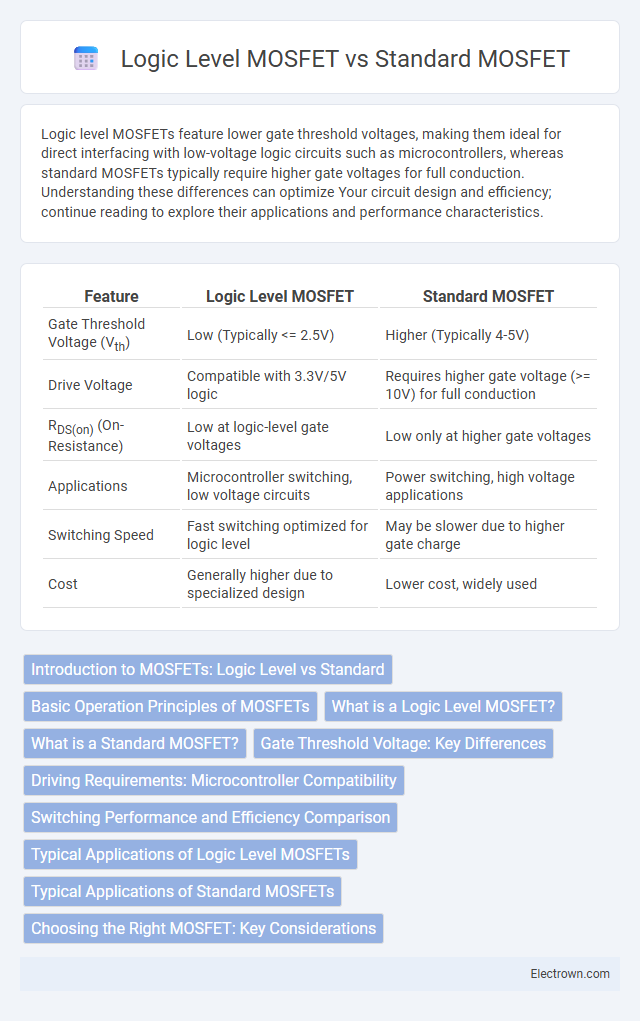Logic level MOSFETs feature lower gate threshold voltages, making them ideal for direct interfacing with low-voltage logic circuits such as microcontrollers, whereas standard MOSFETs typically require higher gate voltages for full conduction. Understanding these differences can optimize Your circuit design and efficiency; continue reading to explore their applications and performance characteristics.
Table of Comparison
| Feature | Logic Level MOSFET | Standard MOSFET |
|---|---|---|
| Gate Threshold Voltage (Vth) | Low (Typically <= 2.5V) | Higher (Typically 4-5V) |
| Drive Voltage | Compatible with 3.3V/5V logic | Requires higher gate voltage (>= 10V) for full conduction |
| RDS(on) (On-Resistance) | Low at logic-level gate voltages | Low only at higher gate voltages |
| Applications | Microcontroller switching, low voltage circuits | Power switching, high voltage applications |
| Switching Speed | Fast switching optimized for logic level | May be slower due to higher gate charge |
| Cost | Generally higher due to specialized design | Lower cost, widely used |
Introduction to MOSFETs: Logic Level vs Standard
Logic Level MOSFETs are designed to fully turn on at lower gate voltages, typically around 4.5V or less, making them ideal for direct interfacing with microcontrollers and low-voltage logic circuits. Standard MOSFETs require higher gate voltages, usually 10V, to achieve optimal performance and lower on-resistance, which suits power applications with dedicated gate drivers. Understanding the voltage requirements of Logic Level vs Standard MOSFETs helps optimize your circuit design for efficiency and reliability.
Basic Operation Principles of MOSFETs
Logic level MOSFETs are designed to fully switch on at lower gate voltages, typically around 4.5V or less, making them ideal for low-voltage digital circuits. Standard MOSFETs require higher gate voltages, usually near 10V, to achieve full conduction, which suits traditional high-voltage applications. Understanding your circuit's voltage levels ensures optimal MOSFET selection for efficient switching and minimal power loss.
What is a Logic Level MOSFET?
A Logic Level MOSFET is designed to fully turn on at lower gate-source voltages, typically around 5V or less, making it ideal for direct interfacing with microcontrollers and low-voltage logic circuits. Unlike Standard MOSFETs, which require higher gate voltages (usually 10V) to achieve full conduction, Logic Level MOSFETs ensure efficient switching and reduced power loss in low-voltage applications. Your choice of a Logic Level MOSFET can significantly improve the performance and reliability of electronic devices operating from logic voltage levels.
What is a Standard MOSFET?
A Standard MOSFET is a type of Metal-Oxide-Semiconductor Field-Effect Transistor designed to operate with a gate threshold voltage typically between 2 to 4 volts, requiring higher gate drive voltages to switch fully on. It is commonly used in applications where the control voltage is sufficiently high, such as in power supplies and motor drivers. Understanding the difference between Standard MOSFETs and Logic Level MOSFETs helps you select the appropriate transistor for low-voltage digital circuits.
Gate Threshold Voltage: Key Differences
Logic level MOSFETs feature a lower gate threshold voltage, typically between 1V to 2.5V, enabling them to fully switch on at standard logic signal levels (3.3V or 5V). Standard MOSFETs usually have a higher gate threshold voltage, often above 2.5V, requiring greater voltage to achieve full conduction. This key difference makes logic level MOSFETs ideal for microcontroller-driven applications where gate drive voltage is limited.
Driving Requirements: Microcontroller Compatibility
Logic Level MOSFETs require a lower gate threshold voltage, typically around 1.5 to 2.5 volts, making them ideal for direct interfacing with microcontrollers operating at 3.3V or 5V logic levels. Standard MOSFETs generally need higher gate voltages, around 4 to 10 volts, often necessitating additional driver circuits for proper switching. Using a Logic Level MOSFET ensures Your microcontroller can efficiently control high-current loads without extra hardware complexity.
Switching Performance and Efficiency Comparison
Logic level MOSFETs offer improved switching performance due to their lower gate threshold voltage, enabling faster transistor turn-on at standard logic voltages like 5V or 3.3V. Standard MOSFETs typically require higher gate voltages (10V or more) for optimal conduction, resulting in slower switching speeds and increased power loss during transitions. Your choice between these MOSFET types directly impacts overall efficiency, with logic level MOSFETs reducing gate drive power consumption and heat dissipation in low-voltage, high-frequency switching applications.
Typical Applications of Logic Level MOSFETs
Logic level MOSFETs are commonly used in low-voltage digital circuits such as microcontroller-based systems, battery-powered devices, and CPU power management. Their ability to fully switch on at lower gate voltages makes them ideal for interfacing directly with 3.3V or 5V logic signals found in embedded systems and portable electronics. These characteristics enable efficient switching in applications like load switching, motor drivers, and power distribution in compact, low-power designs.
Typical Applications of Standard MOSFETs
Standard MOSFETs are widely used in high-power applications such as motor drives, power supplies, and amplifiers due to their ability to handle higher voltages and currents. These devices excel in industrial machinery, automotive electronics, and power management systems where switching efficiency and thermal performance are critical. Their robust design supports heavy current loads, making them ideal for switching regulators and DC-DC converters in various electronic circuits.
Choosing the Right MOSFET: Key Considerations
When choosing the right MOSFET for your application, consider the gate threshold voltage, as Logic Level MOSFETs typically have a lower threshold (around 1-2V) compared to Standard MOSFETs, making them ideal for low-voltage signal driving, such as from microcontrollers. Evaluate the on-resistance (R_DS(on)) which impacts efficiency and heat dissipation; Logic Level MOSFETs generally offer lower R_DS(on) at lower gate voltages. Ensure compatibility with your driving voltage and load requirements to maximize performance and reliability in your circuit design.
Logic Level MOSFET vs Standard MOSFET Infographic

 electrown.com
electrown.com